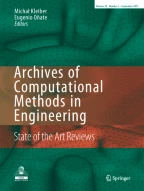
This paper aims to review the recent progress in the research carried out by scientists worldwide regarding American Footballers' head injuries and head protective equipment, focusing on the role of computation methods, mainly finite element method application to American Football helmet design and testing as well as head injury biomechanics. The helmet technology has been constantly improved, and it is driven by market competition, medical records, coaches and athletes' self-awareness. With finite element analysis and computational resources development, it is possible to develop more accurate brain models to recreate American Footballers' head impacts. This method seems to be an excellent simulation tool to verify the helmet's ability to absorb energy and enable the researchers to have an insight into head kinematics and tissue-level injuries. The work is focused on head injuries in American Football as the sport becomes more popular across the globe. Additionally, a reference to the development and newest technology is presented. The review's proposed approach gathers studies presented within the last decade regarding the coupling of finite element brain models with helmets in standardised or on-field conditions. The synthesis of the existing state of the art may enhance the researchers to continue investigating the athlete's trauma and improve the protective gear technology to minimise head injuries. The authors presented numerous studies regarding concussions and the newest findings from the last decade, including Finite Element Head models (FEHm) with American Football helmet simulations. All the studies were searched through Google Scholar, Scopus and ResearchGate databases.
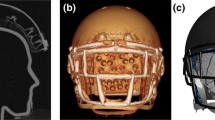
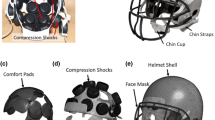
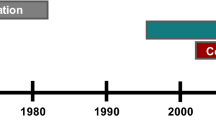
Avoid common mistakes on your manuscript.
In the beginning, the authors would like to highlight the terminology used in this article related to head and brain injuries. The public tends to associate the negative symptoms to “brain injury” (judged as more serious) rather than to “head injury” (less severe, in their view), despite the fact the description may be related to the same injury event [1]. Thus, the authors will use the terms head/brain injury interchangeably regarding brain injury.
At the professional and amateur level of contact sports such as martial arts, it is a challenge to avoid brain trauma, thus the number of brain injuries in sports is significant [2]. However, not only martial arts injury is highlighted in the head injuries statistics in sport. Each year, there are many reported concussions in American Football across the United States (Finite element (FE) models have been used as a research tool for over a decade to investigate brain kinematics and injury mechanisms (Table 1) [24]. Various detailed FE brain and helmet models have been validated and used by researchers to evaluate the probability of injury by verifying brain strain, stress or intracranial pressure (ICP). Even though this approach is rather theoretical, as there is no study backing the results with, e.g. cadaver studies, it can significantly benefit and increase the knowledge.) [3,4,5,6]. Lincoln et al. [7] examined over 2 600 concussions in over 10 000 000 exposures at the high school level (incident rate 0.24 per 1 000). American Football accounted for more than half of all concussions, and it had the highest incidence rate (0.60). Women football had the most concussions among the ladies' sports and the second-highest incidence rate of all 12 sports (0.35) [7]. A similar issue of numerous head injuries was reported in Rugby Union or Australian Football, where players do not wear the protective equipment as in American Football [8,9,10].
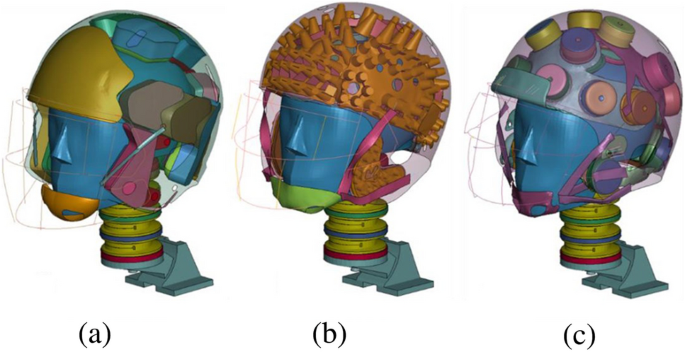
The criteria of helmets validation are based on longitudinal and rotational acceleration. The Severity Index (SI), based on linear acceleration acting on the head's center of gravity, is an example of the criteria employed. These threshold criteria are proposed by the National Operating Committee of Standards for Athletic Equipment (NOCSAE) [25,26,27,28]. These criteria seem to be a simplification of the complex impact kinematics. It must be noted that the human brain and skull cannot be simply treated as rigid structures. Additionally, during the impact, the momentum of the brain tissue differs from the skull’s momentum.
The academic institutes that develop numerical American Football helmet models are e.g.: University of Waterloo, Arizona State University, University of Alabama and University of Virgina, Wayne State University, Mississippi State University, Wroclaw University of Science and Technology, University of Aveiro, KTH Royal Institute of Technology. The vast majority of researchers use the finite element helmet models shared by the NFL “Play smart, Play safe” programme. The idea of this founded research was to obtain various helmet models and share them across the public via Biocore to encourage scientists to improve the understanding of trauma to the head of NFL players, to collaborate with helmet manufacturers and other companies, entrepreneurs and universities to develop highly safe protective equipment. The exemplary Ridell Revolution Speed Classic model (Fig. 1a) is composed of 53 separate parts and 147 384 elements. The validation of each material models was based on compression, shear and tension tests. A total of 62 simulations were performed with the full helmet model, using either an HIII or NOCSAE headform to validate the helmet [29].
The initial helmet function was to prevent the skull from fractures since these injuries are usually very severe and lead to disability or death. The limitation of the helmet design is the mass and size–i.e. the inertia and moments of inertia–the parameters, which influences the head and neck biomechanics [30].
In this review, the authors collected the studies from the last decade regarding finite element analysis of American Football helmets impacts with implemented brain models. There are numerous different approaches to collect the data and recreating using the analysis. Collecting and critically reviewing the existing research will highlight the gaps within the existing literature, and it shall motivate the researchers to continue investigating athletes' trauma and improve protective gear technology to minimise head injury.
The helmet structure can be divided into two major parts. The hard outer shell is responsible for distributing the impact force over the liner’s area. Due to this phenomenon, the energy absorption is increased. Consequently, the probability of head injury is decreased. Additionally, the rigid structure acts as a penetration resistance and initial shock absorber. The second part is attached inside the helmet’s shell–the energy-absorbing material, usually polyurethane foam. The primary function is to absorb impact energy and reduce the head's deceleration by viscoelastic compression [31, 32].
These are the main characteristics of a helmet, independently of the type and application. Although, these define the design in terms of materials, geometries, etc., by having different criteria, the advances or new configurations/systems developed for one type of helmet, can be redesigned for other applications. For instance, the solutions designed to mitigate the head injuries caused by rotational acceleration among motorcyclists/bikers [33].
The structure cannot be heavy as it will decrease the comfort and potentially increase spinal injuries probability. The perfect balance between the inner layer's stiffness and thickness must be met to maximise the energy absorption [34]. For example, when the liner is excessively soft, the head may compress it completely upon impact, which results in no further energy-absorbing capacity of the material. Since the outer liner is a rigid structure, the head suddenly stops, which results in high accelerations induced to the brain. On the contrary, if impact speed is lower than the one for which it was designed, the head decelerates more abruptly than necessary given the available thickness [33].
During the impact, the head is subjected to numerous acceleration magnitudes; thus, the brain may move inside the skull due to its inertia. Depending on the acceleration, the movement may lead to severe injuries as the brain moves backwards inside the skull (during frontal impact), squeezing the tissue near the impact site and stretching the tissue on the opposite side of the head. Next, the brain bounces in the opposite direction stretching the tissue near the impact site and squeezing on the other side (Fig. 2). This coup and contrecoup behaviour can be explained as the brain is suspended inside the skull in cerebrospinal fluid (CSF) [35, 36]. However, the CSF usually does not provide enough cushioning for high energy impacts [37]. The forces during head impact may cause significant damage to brain tissue and bridging veins structure causing brain swelling and bleeding [33].
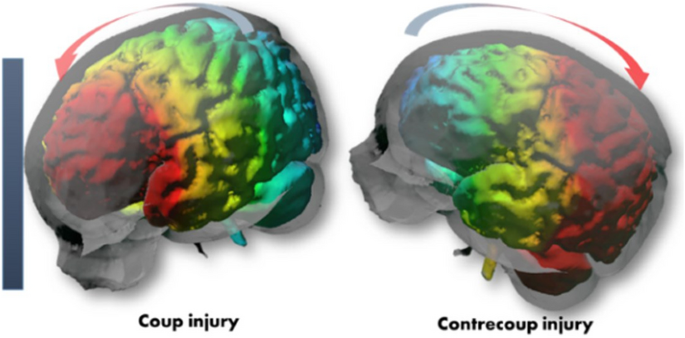
The American Football helmet history reaches back to the end of the XIX century. The very first use of a helmet during the game was documented in 1893 in an Army-Navy game [38]. In the beginning, American Football helmets were mostly leather and shaped in beehive, flat-top or dog-ear style (Fig. 3) [39]. From this point, helmets have significantly evolved and biomechanical researchers have better insight into the head's biophysical characteristics and the development of kinematic head injury [40].
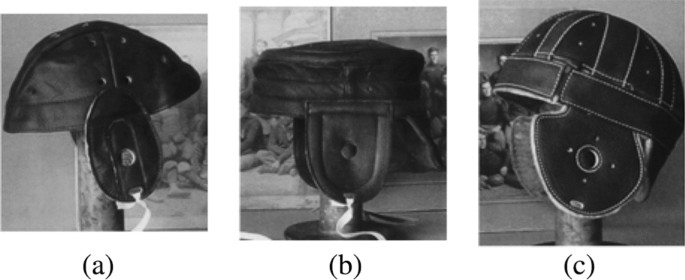
The American Football helmet is designed to protect the players head during tackles and ground impacts. However, the structure cannot fully protect from injuries to the head and neck. The use of helmets became mandatory in 1939, first in NCAA, and later in 1940 for National Football League (NFL) [38]. With time, helmet engineering has been improved and the use of metal alloys and polymers became common to provide more protection. The first helmets with a simple facemask one bar structure were introduced in 1951 and two-bar facemask design in 1958 (Fig. 4). Due to numerous head and spinal injuries occurring in American Football, the NOCSAE was founded in 1969, and the first safety standards for helmets were established in 1973 [41,42,43]. Since then, helmet technology has improved rapidly [44]. According to Schneider et al. [45], football helmets should be explicitly constructed based on an anatomic knowledge of the skull and brain to understand the mechanical principles involved in head injuries. Schneider stated that the helmet's outer shell should be constructed to cover either the skull's fragile areas, which might fracture or cover specific portions of the intracranial contents, most frequently vulnerable to head injuries that may result in concussion [39].

Since then, leading brands of American Football helmets (e.g. Riddell, Schutt, Xenith) have endeavoured to enhance the design and players safety (Fig. 5). Currently, there are multiple models available on the market. Each company investigates the rigid structure's energy dissipation: the outer shell and the soft layer inside the helmet, i.e. TPU (thermoplastic polyurethane) cushioning, or low-density foam coupled with a polymer layer. The innovative mechanism is used by Schutt company in the F7 model [47]. The proposed solution is to implement the tectonic plates strategically on the outer shell that move independently of the helmet shell. This solution increases the helmet's performance against rotational forces [47]. Riddell proposes another solution–the shell is manufactured so that there is a cut-out on the front. During impacts, the plate bends and dissipates the energy [48]. Both producers point out how important it is to have a perfectly fitted helmet with a faceguard. The other companies have unique ideas to enhance the stabilization of the helmet on the player’s head. Xenith focused on the padding inside the helmet, which are dual-stage shock absorbers that work together in response to linear and rotational forces. The pads can move individually during the impact, being compressed separately or moving laterally [49].
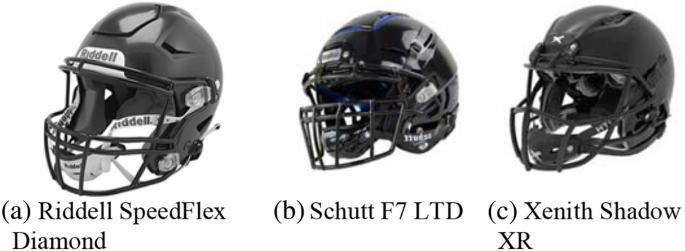
NOCSAE standards, introduced in 1973, required using a head model that mimics the human head's response to impact. The standards are based on the helmet falling in a guided fall. In each case, the helmet is positioned on a head form, which is a human-like representing dummy (Fig. 6). It is constructed to provide the data during impact tests. The goal of the regulations was to measure the football helmet's capacity to withstand repeated blows of various magnitudes under a wide variety of playing conditions without any sacrifice in protective quality [39]. The drop impact is specified by six different points of impacts and four different velocities: 3.46, 4.23, 4.88, 5.46 m/s) [27, 50,51,52] any pneumatic ram test conducted on the medium headform shall not exceed 6000 rad/s 2 [27].
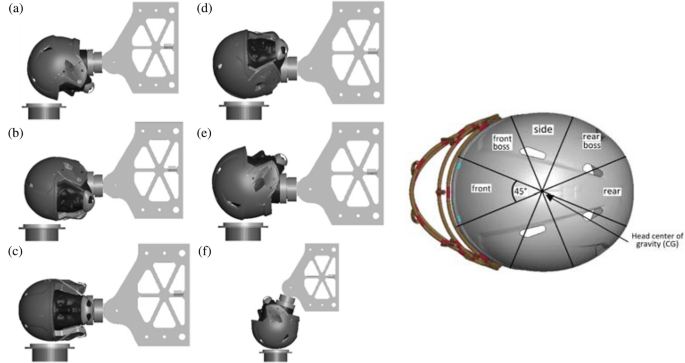
In the STAR evaluation system, proposed by Virginia Tech University, helmet's performance is measured by the capacity to reduce linear and rotational acceleration of the head resulting from a set of impacts. The tests are performed by a pendulum impactor with four impact locations and three velocities: 3.1, 4.9, and 6.4 m/s. Another significant difference between the NOCSAE and STAR tests is the helmeted medium NOCSAE head custom-fit to a Hybrid III neck. The head and neck are mounted to a 5-degree-of-freedom Biokinetics slide table with a 16 kg sliding mass.
Currently, the drop impact is performed with a human-like anthropomorphic test device (ATD), equipped with accelerometers in the headform’s center of gravity. The registered data is longitudinal and rotational accelerations measured through an accelerometer. Furthermore, the SI is calculated as (1):
$$> = \mathop \int \limits_^ A^> dt$$where: A is the instantaneous resultant acceleration expressed as a multiple of g (acceleration of gravity), dt is the time increments in [s], the integration is carried over the essential duration (t) of the acceleration pulse. The peak SI shall not exceed the value of 1200, and the peak rotational acceleration of this setup allows for linear and rotational motion to be generated and represents the head, neck, and torso of a 50th percentile male. Further, the STAR rating is calculated by Eq. (2) to predict concussion incidence of one player over a season [53,54,55].
$$> = \mathop \sum \limits_>^ \mathop \sum \limits_>^ E\left( \right) \cdot R\left( \right)$$Equation (2) bases on laboratory tests that represent the range of on-field impacts seen in college American Football and associates with each impact the number of times it would occur over one season (exposure) as well as the associated probability of concussion (risk). The STAR value is found by multiplying the predicted on-field exposure (E) at each impact location (L) and velocity (V) by the risk of concussion (R) for that impact using the peak resultant linear acceleration (a) and rotational acceleration (α) from laboratory impacts [53]. All of the presented above helmets have a rating equal to 5 stars (highest possible). However, the results vary from 0.75 for Schutt F7 LTD, 1.69 for Riddell SpeedFlex Diamond and 1.91 for Xenith Shadow XR, where the performance rating is from lowest to highest (the lower, the better).The review can be defined into two main groups of interest. The first group contains the research based on laboratory tests, where the helmet is subjected to either impactor or a drop impact. These tests are to mimic validation tests. With this approach, researchers investigate the helmet's stress or strain distribution and verifying if the threshold criteria for head injury are met. The second approach is based on recreating the real-life impacts. The data are recorded during practices, games, or assumed scenarios based on observation of multiple impacts (Table 2). The experimental data are mostly recorded by either dummy sensors or accelerometers attached inside the helmet in both scenarios. The specialists from Stanford University presented a novel mouthguard approach [56, 57]. The researchers investigated whether the motion is precisely transferred onto the skull with developed wearable devices to measure head and helmet kinematics. Since the skin lower stiffness raised concerns, the instrumented mouthguards were introduced to measure the head kinematics. Thanks to this approach, the recorded accelerations and velocities are exclusive of the skull.

Dymek et al. [70] presented a different approach, where the ICP is investigated in 8 different NOCSAE setups. Additionally, the ICP calculated with the αHEAD model is compared to the Head Injury Criterion (HIC) calculated with the Hybrid III Head-Neck model. The authors underline the disadvantages of criteria based on longitudinal acceleration as most impacts in sports, racing or urban situations are oblique. This is why the longitudinal acceleration is relatively low–mostly below the HIC thresholds–while values of rotational acceleration are critical. Bearing in mind that skull bones are more vulnerable to side impacts than longitudinal impacts, this can significantly affect the probability of head injury [80]. This study proves that even though HIC values are permissible (HIC threshold value is 1000), more robust parameters such as the presented ICP exceed threshold values (app. 237 kPa) in each tested configuration [27, 81]. The ratio of 3D finite elements in the modelled brain tissue exceeding the threshold criterion varies from 20 to 29%. However, it is necessary to point out that αHEAD is based mainly on a tetrahedral mesh approach – thus, the studies shall be continued with more advanced models.
Honarmandi et al. [71] proposed a study based on a simple contact model, where the angle of impact, θ, varied from 0 to 45° for each player in a helmet-to-helmet impact (Table 4). The coefficient of restitution was established as e = 0.45, where e = 1.0 is perfectly elastic and e = 0 is perfectly plastic condition. The time of simulation was established to 7.2 ms. The conservation of momentum was applied to the system of two players along with the coefficient of restitution to obtain the velocities after impact. Then, the impulsive force was obtained by employing the principle of impulse and momentum on one of the players. The interesting aspect considered is the variation of mass for different positions on the field, combining realistic scenarios and a portion of players’ masses. To summarise, there were 28 separate cases.
Table 4 Scenarios concerning positions on the field and impact locations presented by Honarmandi et al. [71]
Ghajari et al. [72] presented three distinct types of injurious scenarios, a helmet-to-helmet impact in American Football, an occipital head impact due to a fall from ground level, and a road traffic accident involving a helmeted motorcyclist. Ghajari et al. [72] underline that the developed brain model will allow a detailed investigation of brain deformation during impact loading, especially the differences between sulci and gyri deformation. The velocity of the striking player was estimated by analyzing the video footage of the game. Then, the collision was reconstructed in the lab by representing the players with dummies, launching one dummy towards the other at the estimated impact velocity, and measuring the struck dummy's head's accelerations. The finite element model predicted a patchy distribution of strain and strain rate within the brain, with both strain and strain rate being greatest in the sulci. It was confirmed that the distinction between the maximal strain and strain rate in the sulci and gyri by mapping out these fields at the grey-white matter interface [82, 83].
A notable number of 148 reconstructed head impacts from video footage of American Football games is presented by Zimmerman et al. [73]. The players were separated into three different position profiles based on magnitude and frequency impacts. The study proves that the possibility of concussion varies between positions, for example, defensive backs or wide receivers are exposed to a large magnitude, low-frequency impacts and lineman to low magnitude, high-frequency. It was found that player position in American Football affects the magnitude of strain and strain rate across the brain, particularly in sulci. This is likely due to the effect of player position on impact kinematics. The large strain and strain rate may explain the higher concussion rate in offensive and defensive linemen positions. However, the impact frequency is likely a critical factor in producing the neurodegenerative processes at lower strains than those required to produce concussion-like symptoms. This is a limitation of the study, which needs to be addressed when more information is available on the repetitive effects of forces on primary and secondary progressive damage to the brain.
The American Football helmet aims to protect the head from mechanical injuries and reduce the probability of traumatic brain injury. The different energy-absorbing technologies are implemented in various presented solutions to dissipate impact energy. The current development tendency is to focus on the soft inner layer of energy-absorbing materials. Schutt company introduced an interesting technology of tectonic plates, strategically placed on the outer shell that moves independently of the helmet. Both producers and NOCSAE indicate that football helmets may not fully protect the player. Other research communities have made similar conclusions in the literature [58, 84,85,86,87,88,89,90,91,92].
The reviewed study regarding finite element analysis has shown that current helmet validation standard tests may not cover the common spectrum of head injuries and further, there is no decision on the best update (Table 5). The main conclusion is that there is no precise predictor of what the cause of injury might be. Various injury criteria based on accelerations, strains or stresses are still under investigation. A similar conclusion is presented in the literature concerning, i.e. motorcycle helmets [33, 93].
Table 5 Summary of reviewed researchNevertheless, one of the issues that will certainly continue to be studied is chronic traumatic encephalopathy (CTE) in football players. The increasing number of former players being diagnosed with such pathology will have an impact in the future of head protection in sports, particularly in contact sports with repetitive head impact as is the case of American Football. Changes to mitigate such a serious problem can go from game rules to head impact protection. Another interesting point would be an analysis of forces acting on the neck and their interpretation in terms of Neck Injury Criteria (NIC) or Normalized Neck Injury Criteria (Nij).
CTE is being linked with repeated brain injuries and long-term brain changes that reflect in the form of symptoms such as memory loss, impaired judgment, aggression and depression [3, 21,22,23]. Therefore, CTE diagnosis in a short-term period is a challenge. Although there are already reported cases in living individuals [94, 95], most are diagnosed post-mortem. FE models and virtual testing can be put together to understand the mechanisms of repeated head impacts that cause minor impairment, but their cumulative effect might result in long-term issues. The attenuation of a wide range of impacts, for different impact energies, reflecting on the impact velocity and a wide range of strain rates, and even on the impact surface and object, might be the key for safer helmets in contact sports. Computational modelling plays the role of enabler, making it possible to optimize the helmet for several scenarios.
In the review, there are presented studies with eight different FE head models. However, there are more available head models in the literature, such as Worcester head injury model [96], Yet Another Head Model [97] or Wayne state University brain injury model [98]. Each academic institute, developing the brain models, focuses on different strategies, which results in the variety of geometry and, thus, results. To share a bigger picture of the head injuries studies, it would be beneficial to implement all available FE head models and compare the results.
Currently, the results in the literature show a trend where the regions that incur the largest deformations are generally in areas opposite to the impact site. These results could also shed some light on the possible reason why there are so many different symptoms of concussion. The results indicate that depending on the impact's location, a different brain region would incur larger deformations and be susceptible to injury [67]. The loading conditions presented were not intended to replicate impacts that cause mTBI but to replicate NOCSAE standard impacts assumed as dangerous impact conditions. According to injury thresholds, values obtained in these loading conditions may lead to potential injury conditions through high strain rates observed in the corpus callosum, midbrain and brainstem [58].
The helmet design is a multidisciplinary task that incorporates knowledge from different fields, from the engineering side with materials and design to medicine with the understanding of injury biomechanics. Currently, advances in helmet design have been made thanks to advances in these areas, where computational tools play an essential role. For instance, at the moment, one of the most sounding technologies in helmet design is the VICIS Zero1 helmet, with an innovative liner for American Football helmets that may be effective in reducing diagnosed concussions and reducing symptoms [99]. In a study conducted by Rivara and Gause [99], the number of coach-reported concussions was fewer in the season in which players wore the VICIS Zero1 helmet and on average the players felt better and had fewer headaches.
Finite element head models can play a groundbreaking role in the design of football helmets, considering some of the conclusions obtained in the studies carried out by Camarillo research group. In one study, high tensile strains were found in the corpus callosum during the reconstruction of a head impact in an American Football game where the player suffered a concussion [100]. Therefore, FE head models can be used to optimize football helmets to mitigate serious outcomes. Additionally, it is expected that advances in computational biomechanics will help to deeply understand the mechanisms of injury through the employment of advanced numerical models at the level of fluid–structure interaction or multiscale modelling. There is a tendency to create models with the highest accuracy and lowest computational time. Unfortunately, these two aspects do not go in pair. Hopefully, with the computer units development, it will be possible to analyse the most complicated models within hours. The numerical biomechanics research has made a major contribution to understanding the mechanisms of injuries and designing sport protective equipment such as helmets.
Regulations for American Football helmets are important but should be improved to target these issues and help prevent concussions and their repetition. It is necessary to remember that the threshold criteria are mainly based on skull fracture caused by the impact. Back in the days, the assumption was as such that if there is a skull fracture, then brain damage is inevitable. With today’s medical and engineering knowledge, it is possible to distinguish different brain injuries and their mechanisms. Therefore, test standards should reflect the later scientific developments.
The publication was developed as part of project LIDER/8/0051/L-8/16/NCBR/2017 funded by the National Centre for Research and Development, Poland.